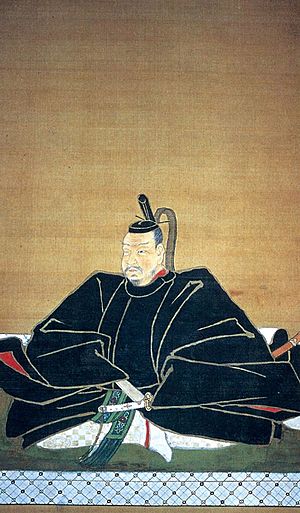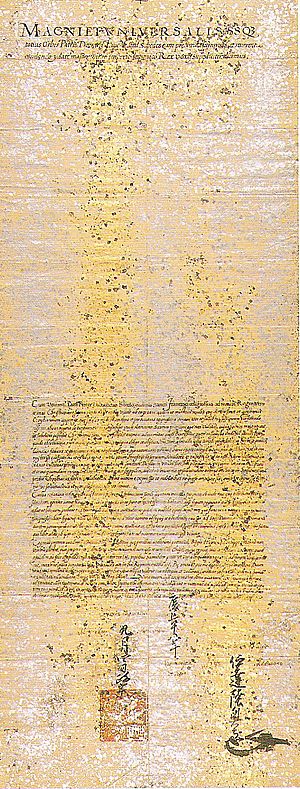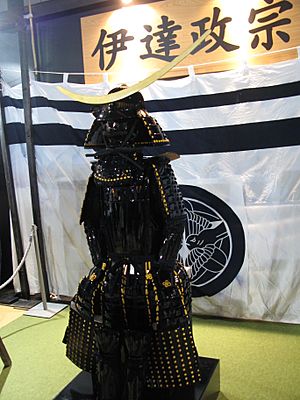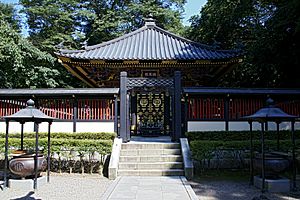Date Masamune facts for kids
Quick facts for kids
Date Masamune
伊達政宗 |
|
|---|---|
 |
|
| Head of Date clan | |
| In office 1584–1636 |
|
| Preceded by | Date Terumune |
| Succeeded by | Date Tadamune |
| Daimyō of Sendai Domain | |
| In office 1600–1636 |
|
| Succeeded by | Date Tadamune |
| Personal details | |
| Born | September 5, 1567 Yonezawa, Yamagata |
| Died | June 27, 1636 (aged 68) Edo, Japan |
| Height | 159.4 cm (5 ft 3 in) |
| Spouse | Megohime |
| Children | Date Hidemune Date Tadamune Irohahime Muuhime |
| Parents |
|
| Relatives | Rusu Masakage (uncle) Date Masamichi (brother) Date Shigezane (cousin) Mogami Yoshiaki (maternal uncle) |
| Nickname | "Dokuganryū" |
| Military service | |
| Allegiance | |
| Rank | Daimyo |
| Unit | |
| Commands | Sendai domain |
| Battles/wars | Battle of Hitotoribashi Battle of Kōriyama Siege of Kurokawa Battle of Suriagehara Kunohe Rebellion Korean Campaign Siege of Shiroishi Siege of Hasedō Battle of Matsukawa Osaka Campaign |
Date Masamune (伊達 政宗, September 5, 1567 – June 27, 1636) was a powerful Japanese leader. He lived during a time when Japan was often at war, known as the Azuchi–Momoyama period and early Edo period. He was the heir to a strong family called the Date clan in the Tōhoku region of Japan.
Masamune is famous for founding the modern city of Sendai. He was a brilliant military leader and was known as dokuganryū (独眼竜), which means the "One-Eyed Dragon of Ōshu". This nickname came from him having only one eye. Because he was such a legendary warrior, Masamune often appears as a character in Japanese historical dramas called Jidaigeki.
Contents
Early Life and Becoming a Leader
Date Masamune was born as Bontenmaru in Yonezawa Castle. This castle was in what is now Yamagata Prefecture. His father was Date Terumune, the head of the Date clan.
When Masamune was 14 years old in 1581, he led his first battle. He helped his father fight against the Sōma clan. In 1584, at just 17, Masamune took over from his father as the daimyō (a powerful feudal lord). His father decided to retire. Masamune's army was easy to spot because they wore black armor and golden helmets.
Masamune was unique among the leaders of his time. His famous helmet, which had a crescent moon shape, made him look very fierce. When he was a child, he lost sight in his right eye because of smallpox. It's not fully clear how he lost the eye completely. Some stories say he pulled it out himself. Others say his trusted helper, Katakura Kojūrō, removed it for him. This is how he became known as the "One-Eyed Dragon."
The Date clan had made friends with nearby clans through marriages. But small fights were still common. Soon after Masamune became leader in 1584, one of his helpers, Ōuchi Sadatsuna, switched sides to the Ashina clan. Masamune declared war on them for this betrayal. He started a campaign to find Sadatsuna. He even attacked his own relatives who were allies of Sadatsuna.
In 1585, a leader named Nihonmatsu Yoshitsugu felt he was losing. He decided to surrender to Masamune. Masamune agreed, but only if Yoshitsugu gave up most of his land. This made Yoshitsugu angry. He kidnapped Masamune's father, Terumune. During a chase near the Abukuma River, both Terumune and Yoshitsugu were killed.
Masamune swore to get revenge for his father's death. In January 1586, he attacked the Nihonmatsu clan in the Battle of Hitotoribashi. The Date clan fought many more battles with their neighbors. These included the Battle of Koriyama in 1588 and the Battle of Suriagehara in 1589. After beating the Ashina clan, Masamune made Kurokawa Castle his main base.
Working with Hideyoshi
In 1590, Toyotomi Hideyoshi was the most powerful ruler in Japan. He captured Odawara Castle and told all the leaders in the Tōhoku region to join his campaign. Masamune first refused Hideyoshi's orders. But he soon realized he had no choice. Hideyoshi was practically the ruler of all Japan.
Masamune still arrived late, which made Hideyoshi very angry. Masamune expected to be put to death. But he faced Hideyoshi bravely, wearing his best clothes. Hideyoshi decided to spare him, saying Masamune "could be of some use."
Because Masamune was a strong leader in northern Japan, Hideyoshi watched him closely. Hideyoshi reduced the size of Masamune's lands because he was late to the Siege of Odawara.
In 1591, Masamune had to give up his family's old lands to Hideyoshi. This caused many protests. He never got those lands back. After helping to stop the Kunohe Rebellion, Masamune was given new lands. He moved there, rebuilt Iwadeyama Castle, and renamed the area Iwadeyama. He helped a town grow around the castle. Masamune lived in Iwadeyama for 13 years. He made it an important place for politics and business.
Masamune and his soldiers also fought well in Hideyoshi's invasions of Korea between 1592 and 1598.
Working with Ieyasu
After Hideyoshi died in 1598, Masamune started to support Tokugawa Ieyasu. This was likely on the advice of his helper, Katakura Kojūrō. Ieyasu became the new most powerful leader in Japan. He gave Masamune more land, but he was always a bit suspicious of Masamune.
Even though Ieyasu and others were wary of him, Date Masamune mostly served the Tokugawa family loyally. In 1600, he fought with Ieyasu's eastern army in the Sekigahara Campaign. He took part in the Siege of Shiroishi and the Siege of Hasedō.
Later, Ieyasu rewarded Masamune by making him the lord of the large and rich Sendai Domain. This made Masamune one of Japan's most powerful daimyō. Ieyasu had promised Masamune a huge domain. Even after improvements, the land produced a lot of food and resources.
In 1604, Masamune moved to a small fishing village called Sendai. He brought 52,000 of his followers and their families with him. He left his fourth son, Date Muneyasu, to rule Iwadeyama. Masamune worked hard to turn Sendai into a big and successful city.
In 1614, he fought in the Osaka campaigns against the Toyotomi Clan. This was to help Ieyasu completely take control of Japan.
In 1616, when Tokugawa Ieyasu was dying, Masamune visited him. He read Ieyasu a Zen poem. Masamune was respected for his strong moral values. A famous saying of his is: "Being too strict makes you stiff; being too kind makes you weak."
Death
Date Masamune passed away in 1636 at 68 years old. He died from a mix of esophageal cancer and peritonitis. His body was brought back to Sendai in a grand procession, just like when he was alive. The government allowed his oldest son, Date Tadamune, to become the new head of the Date clan.
Supporter of Culture and New Ideas

Masamune helped trade grow in the northeastern Tōhoku region. Even though he faced attacks from other clans at first, he overcame them. He eventually ruled one of the largest areas under the later Tokugawa shogunate. He built many beautiful palaces and worked on projects to make the region look better.
He also welcomed people from other countries to his land. He even helped send a group to meet the Pope in Rome. He was probably interested in new technologies from other countries, just like other leaders of his time. Later, when Tokugawa Ieyasu made Christianity illegal, Masamune had to follow the rule. He allowed Ieyasu to treat Christians in his area harshly, even though he didn't like it.
For 270 years, Tōhoku remained a popular place for visitors, trade, and growth. Matsushima, a group of small islands, was praised for its beauty by the famous poet Matsuo Bashō.
Masamune showed kindness to Christian missionaries and traders in Japan. He let them come and teach in his area. He even helped free a missionary named Padre Sotelo from Tokugawa Ieyasu. Date Masamune allowed Sotelo and other missionaries to practice their faith and gain followers in Tōhoku.

Masamune famously paid for and supported one of Japan's few long-distance journeys of diplomacy and exploration during this time. He ordered the building of a ship called the San Juan Bautista. This ship was built using European ship-building methods.
He sent one of his helpers, Hasekura Tsunenaga, along with Sotelo and about 180 other people. They had a successful trip to build relationships with the Pope in Rome. This journey included stops in places like the Philippines, Mexico, and Spain. Before this, Japanese lords had never funded such a long trip. So, it was likely the first successful one. At least five members of the group stayed in Spain to avoid the persecution of Christians back in Japan. Today, about 600 of their descendants, with the last name Japón (Japan), live in Spain.
When the Tokugawa government banned Christianity, Masamune had to follow the law. However, some people believe that Masamune's oldest daughter, Irohahime, was a Christian.
Family
- Father: Date Terumune
- Mother: Yoshihime (1548–1623), daughter of Mogami Yoshimori
- Wife: Megohime, daughter of Tamura Kiyoaki
- Sibling: Date Masamichi
- Children:
- Date Hidemune
- Irohahime
- Date Tadamune
- Date Munekiyo (1600–1634)
- Date Muneyasu (1602–1639)
- Date Munetsuna (1603–1618)
- Date Munenobu (1603–1627)
- Date Munetaka (1607–1626)
- Mūhime
- Takematsumaru
- Date Munezane (1613–1665)
- Minehime (1616–1632)
- Date Munekatsu (1621–1679)
- Sengikuhime (1626–1655)
- Tsuta
- Watari Munemoto (1600–1669)
Others in his life
- Aunt: Onamihime (1541–1602)
- Wet nurse (foster mother): Katakura Kita (1538–1610), who also mentored Masamune.
"Three Great Men" of the Date Clan
These were three very important and trusted helpers of Date Masamune:
- Katakura Kagetsuna (片倉 景綱, 1557 – December 4, 1615): Also known as Katakura Kojūrō.
- Date Shigezane (伊達 成実, 1568 – July 17, 1646): A cousin of Date Masamune.
- Oniniwa Tsunamoto (鬼庭 綱元) (1549 – July 13, 1640): A senior helper who Masamune trusted deeply.
Other Important Helpers (Retainers)
- Oniniwa Yoshinao
- Rusu Masakage
- Shiroishi Munezane
- Kokubu Morishige
- Yashiro Kageyori
- Tamura Kiyoaki
- Ōuchi Sadatsuna
- Hasekura Tsunenaga
- Katakura Shigenaga
- Inawashiro Morikuni
Important Castles of the Date Clan
These are some of the castles that were important to the Date clan and Date Masamune:
- Yonezawa Castle: The Date clan's original main base from 1548. It might be where Masamune was born.
- Tateyama Castle: Date Terumune lived here after he retired.
- Obama Castle: Masamune stayed here from 1585 to 1586.
- Kurokawa Castle: The Date clan's main base from 1589 to 1591.
- Iwadeyama Castle: The Date clan's main base from 1591 to 1601.
- Aoba Castle: The Date clan's main base from 1601.
- Wakabayashi Castle: Masamune's strong home. He spent most of his time here after rebuilding it in 1627.
- Nihonmatsu Castle: Important to Katakura Kagetsuna and Date Shigezane.
- Hachōme Castle: Important to Date Sanemoto.
- Matsumori Castle: Important to Kokubu Morishige.
- Fukushima Castle: Important to Date Harumune.
- Ōmori Castle: Important to Date Sanemoto and Date Shigezane.
- Shiroishi Castle: Important to Katakura Kagetsuna.
- Iwakiri Castle: Important to Rusu Masakage.
- Watari Castle: Important to Watari Motomune and Katakura Kagetsuna.
See also
 In Spanish: Date Masamune para niños
In Spanish: Date Masamune para niños








